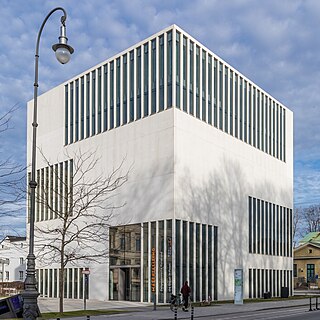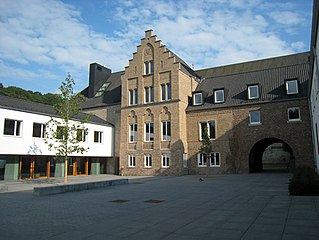
Cologne is the largest city of the German state of North Rhine-Westphalia and the fourth-most populous city of Germany with nearly 1.1 million inhabitants in the city proper and over 3.1 million people in the Cologne Bonn urban region. Cologne is also part of the Rhine-Ruhr metropolitan region, the second biggest metropolitan region by GDP in the European Union. Centered on the left (west) bank of the Rhine, Cologne is located on the River Rhine, about 35 km (22 mi) southeast of the North Rhine-Westphalia state capital Düsseldorf and 25 km (16 mi) northwest of Bonn, the former capital of West Germany.

Bartholomäus (Barthel) Schink was a member of the Edelweiss Pirates, active in the Ehrenfeld Group in Cologne, which resisted the Nazi regime. He was among the 13 members of that group who were publicly hanged in Cologne by the Gestapo on 10 November 1944. Although they were not tried, the group was accused of killing five people and planning an attack on the EL-DE Haus, the local Gestapo headquarters.

Fritz Theilen was a German member of the anti-Nazi resistance group the Edelweißpiraten during World War II. Born to working-class parents, he joined the Deutsches Jungvolk division of the Hitler Youth in 1937, and was excluded for resisting orders in 1940. He started an apprenticeship at the local Ford Motor Company auto plant in 1941. In 1942 he joined the Edelweißpiraten. He was imprisoned at the Gestapo's Cologne headquarters—the EL-DE Haus—in 1943. After managing to escape from prison, he survived in the underground until 1945. Ford only re-employed him after the British occupation force exerted pressure on the company's management.

Pawiak was a prison built in 1835 in Warsaw, Congress Poland.

Museum Ludwig, located in Cologne, Germany, houses a collection of modern art. It includes works from Pop Art, Abstract and Surrealism, and has one of the largest Picasso collections in Europe. It holds many works by Andy Warhol and Roy Lichtenstein.

The Topography of Terror is an outdoor and indoor history museum in Berlin, Germany. It is located on Niederkirchnerstrasse, formerly Prinz-Albrecht-Strasse, on the site of buildings, which during the Nazi regime from 1933 to 1945 was the SS Reich Security Main Office, the headquarters of the Sicherheitspolizei, SD, Einsatzgruppen and Gestapo.

The Brown House was the name given to the Munich mansion located between the Karolinenplatz and Königsplatz, known before as the Palais Barlow, which was purchased in 1930 for the Nazis. They converted the structure into the headquarters of the National Socialist German Workers' Party. Its name comes from early Nazi Party uniforms, which were brown. Many leading Nazis, including Adolf Hitler, maintained offices there throughout the party's existence. It was destroyed by Allied bombing raids during World War II.
Memorials to victims of the KGB have been set up in several countries that were formerly occupied by the Soviet Union, often in former KGB prisons, to document the repressions of the Soviet secret police and to commemorate its victims. Some are in the form of monuments at the location of KGB prisons or execution sites, others are museums and documentation centres.

The Museum of Occupations and Freedom Fights in Vilnius, is dedicated to showing artifacts and records from the 50-year period of Soviet occupation of Lithuania.

Pomorska Museum is a building also known as Silesian House in Kraków, Poland. The word "Pomorska" was for the Kraków 1940s generation a synonym for Gestapo headquarters and operations.

Mausoleum of Struggle and Martyrdom is a museum in Warsaw, Poland. It is a branch of the Museum of Independence. The museum presents the conditions in which Polish patriots and resistance fighters were jailed by Nazi Germany during World War II.

Columbia concentration camp was a Nazi concentration camp situated in the Tempelhof area of Berlin. It was one of the first such institutions established by the regime.

The Erich Klibansky Platz in Cologne quarter Altstadt-Nord, located on Helenenstraße, takes the name of Erich Klibansky, the one-time and last headmaster of the Reformrealgymnasium Jawne, the first Jewish Gymnasium of the Rhineland. It took his name in 1990.

The NS-Dokumentationszentrum (NSDOKU) is a museum in the Maxvorstadt area of Munich, Germany, which focuses on the history and consequences of the National Socialist (Nazi) regime and the role of Munich as Hauptstadt der Bewegung.

Günther Strupp was a German artist, illustrator, and art director. He was a survivor of Kemna concentration camp and of Gestapo imprisonment in Stadelheim Prison.

The NS Documentation Centre of the City of Cologne(German: NS-Dokumentationszentrum der Stadt Köln) was founded by a resolution passed by the Cologne city council on December 13, 1979, and has become the largest regional memorial site in all of Germany for the victims of the Nazis. Since 1988, it has been housed in "EL-DE Haus," the EL-DE building, named for the initials of its owner, Catholic businessman Leopold Dahmen. This building was the headquarters of the Cologne Gestapo between December 1935 and March 1945. In the final months of the war, several hundred people, most of them foreign forced laborers, were murdered in the courtyard of the building. In a bit of historical irony, the EL-DE building remained largely untouched by the ravages of the war.

Arkivet is the established name of Vesterveien 4 in Kristiansand, Norway. The building was constructed in 1935 for the Archival Services in Kristiansand, and in the periods 1935–1940 and 1945–1997 used by this institution. Nevertheless, the building is known as the headquarters of the Gestapo in southern Norway in the period 1942–1945. The building is owned and operated by the foundation Stiftelsen Arkivet. Arikivet is located in the residential area of Bellevue overlooking the western harbor of Kristiansand. The building in the functionalist style was completed in 1935, and was 8 March of that year officially adopted by the local department of the National Archives.

The Villa Pauly was built in 1923 at No. 57, Boulevard de la Pétrusse, in the center of Luxembourg, for the surgeon Dr. Norbert Pauly; the architect was Mathias Martin. With its corner towers, the house mimics the castle architecture of the Late Middle Ages and the Renaissance. Initially Dr Pauly housed his practice in the basement of the building.

Haus Altenberg is a house for education and meetings of young people (Jugendbildungsstätte) of the Diocese of Cologne, located in Altenberg, now part of Odenthal, North Rhine-Westphalia, Germany. It was the centre of the Katholische Jugendbewegung in Germany from 1926 to 1954, interrupted only during World War II. Owned by the diocese, it is run by the association Jugendbildungsstätte Haus Altenberg.
























